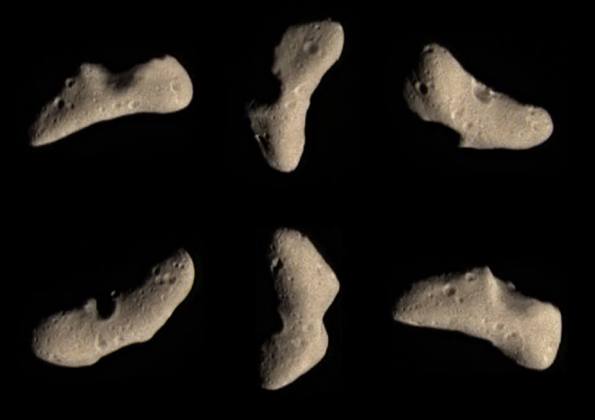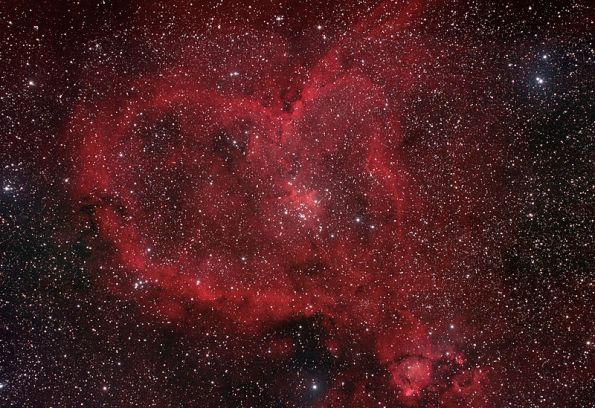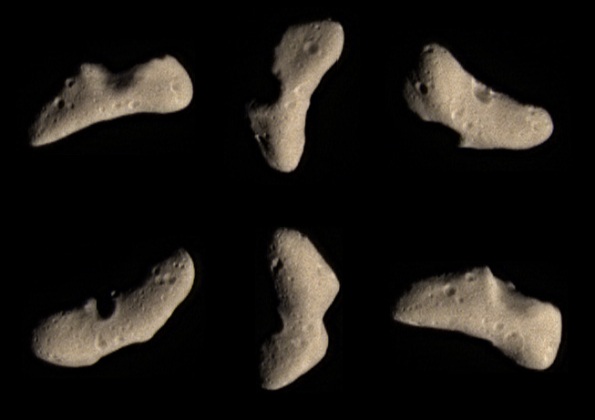Archive
02/14/2022 – Ephemeris – A celestial Valentine’s Day encounter
This is Bob Moler with Ephemeris for St Valentine’s Day, Monday, February 14th. Today the Sun will be up for 10 hours and 25 minutes, setting at 6:10, and it will rise tomorrow at 7:43. The Moon, 2 days before full, will set at 7:40 tomorrow morning.
Twenty-two years ago to the day, the NEAR-Shoemaker* spacecraft entered into orbit of the near Earth asteroid 433 Eros. It wasn’t originally planned to enter orbit of the asteroid named after the Greek god of love on Valentine’s Day, 2000. It arose after an aborted course correction a year earlier. After solving the problem, a new course was plotted and NEAR-Shoemaker was gently inserted into orbit of this 21 mile long asteroid shaped like a bent bread stick with a bite taken out of the center of it. The spacecraft spent almost a year orbiting Eros at various altitudes. The spacecraft ended its mission gently crashing into the middle of the asteroid, where it stayed alive for two weeks before succumbing to the cold.
The astronomical event times given are for the Traverse City/Interlochen area of Michigan (EST, UT – 5 hours). They may be different for your location.
*The name Shoemaker was added to the NEAR spacecraft name after it was launched. NEAR stands for Near Earth Asteroid Rendezvous. It was named for Eugene Shoemaker, a geologist who proved that the Barringer Crater in Arizona was an impact crater rather than a volcanic crater, thus proving, before the Apollo 11 landing on the Moon, that the Moon’s craters were mostly impact craters produced by small asteroids like Eros. Shoemaker and his wife Carolyn, the astronomer in the family, along with David Levy discovered the Comet Shoemaker-Levy 9. The comet had broken into more than 22 pieces and crashed into Jupiter over a week in July 1994, making blemishes in the Jovian clouds that lasted many months.
Addendum

“These color images of Eros were taken by the NEAR probe on February 12, 2000, at a distance of 1,800 kilometers, during the final approach imaging sequence before insertion into orbit. The images show the approximate color of Eros as it would be seen with the naked eye.” Click on the image to enlarge it. Credit
NASA/JPL/JHUAPL. Caption from: https://eros2019.imcce.fr/eros.html via Google Translate.
By the way, the Roman equivalent to Eros was the god Cupid, whose love dart is the constellation Sagitta, which resides within the Summer Triangle of bright stars, to be seen in the evening sky four months from now.
I’ll end with a Valentine heart. The red color is real, it’s due to hydrogen.

IC 1805 (Heart Nebula) Credit: s58y [CC BY 2.0 (https://creativecommons.org/licenses/by/2.0)%5D, via Wikimedia Commons.
02/14/2020 – Ephemeris – Love is in the air, and in space too
Ephemeris for St Valentine’s Day, Friday, February 14th. Today the Sun will be up for 10 hours and 23 minutes, setting at 6:09, and it will rise tomorrow at 7:43. The Moon, 1 day before last quarter, will rise at 1:02 tomorrow morning.
As I said before today is St. Valentine’s day. However one of the symbols of this Christian Saint’s day, beside the red hearts, is the pagan Roman god of love Cupid, the cute counterpart of the Greek god Eros. Cupid supposedly made people fall in love by shooting them with little love darts with his bow. One of those darts is in the sky as the constellation Sagitta the arrow which is visible on summer evenings and now in the early morning. The Roman goddess of love is represented brilliantly in the evening sky as the planet Venus. On St Valentine’s Day, 20 years ago the NEAR-Shoemaker spacecraft entered orbit of the asteroid Eros, and soft landed on it 364 days later. They say love is in the air. Apparently love is in space too.
The times given are for the Traverse City/Interlochen area of Michigan. They may be different for your location.
Addendum

Sagitta the arrow at 6 a.m. these mornings, located within the Summer Triangle of the bright stars Vega, Altair and Deneb. It will be seen at a more convenient time this summer. Created using Stellarium.
Bonus

IC 1805 (Heart Nebula) Credit: s58y [CC BY 2.0 (https://creativecommons.org/licenses/by/2.0)%5D, via Wikimedia Commons

Pluto on July 8, 2015 from the New Horizons spacecraft on approach showing its love for us, or it’s just a heart shaped feature on Pluto’s lower right edge. This is a back & white image colorized by information captured by “Ralph”, a visible and infrared imager. The detail in all these pictures is provided by LORRI the long range imager. Credit: NASA/Johns Hopkins University Applied Physics Laboratory/Southwest Research Institute.
